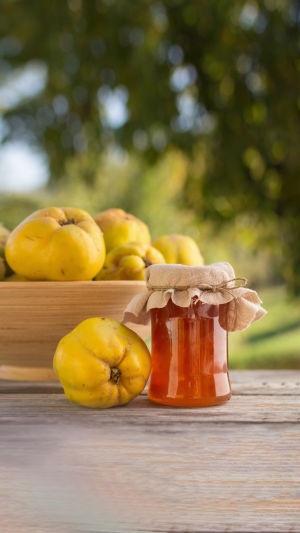Quince is a distinctive fruit originating from a deciduous tree native to the Middle East.
It belongs to the Rosaceae plant family, sharing its botanical roots with apples and pears.
<b>Plant Characteristics</b>
The quince tree is a deciduous marvel, typically growing between 3 to 6 meters in height, with some varieties reaching even greater heights. It has a thick trunk covered with gray-brown bark, and its oval-shaped leaves are short-stalked, displaying a deep green color. In the spring, quince trees bloom with large, striking flowers in shades of pink or white, emitting a pleasant fragrance.
<b>Fruit Characteristics</b>
The most captivating feature of the quince is its fruit. Usually golden or yellow in color, the fruit resembles a pear but can sometimes display orange or green hues. Its smooth surface and firm texture are distinctive, and it can sometimes grow to the size of an apple. The quince is known for its astringent taste, which makes it less palatable when eaten raw. However, when cooked, it releases a unique aroma and texture that enhances various dishes.
<b>Distribution and Cultivation</b>
Originating from the Middle East, the quince has spread worldwide. It thrives in warm and dry climates and can tolerate cold winters to some degree. With the right climate and soil conditions, quince trees grow vigorously and are cultivated in many parts of the world today.
5 Health Benefits of Quince! | Benefits of | Healthy Living Tips
Video by Benefits of
Quinces, being perennial plants, can be propagated through seeds or cuttings. They thrive in well-draining soil and require ample sunlight for optimal growth. Although they have a relatively slow growth rate, mature quince trees are long-lived and produce abundant fruit.
<b>Nutritional Value</b>
Quince fruit is rich in vitamin C, fiber, antioxidants, and other essential nutrients. While its raw texture may not be as appealing as other fruits, the cooking process enhances the quince’s unique flavor and aroma, making it a valuable addition to various dishes. Quinces are also used in the production of jams, syrups, and a variety of pastries and desserts.
<b>Culinary Use</b>
Quinces have a wide range of culinary uses due to their tart flavor. They are commonly used to make jams, juices, cider, and a variety of desserts and pastries. In Mediterranean regions, quince fruits are central to creating “quince jam,” a traditional treat known for its rich, sweet, and delightful taste.
Moreover, quinces serve as a flavorful addition to grilled meats and roasted vegetables, offering a distinctive seasoning. The cooking process reduces the sourness of the quince, transforming it into a unique sweetness that enhances desserts, pies, and pastries.
<b>Traditional Medicine Applications</b>
In certain cultural contexts, quinces have been used in traditional medicine. Rich in vitamins and antioxidants, quinces are believed to offer several health benefits. Historically, they were used as an herbal remedy to alleviate digestive issues, treat coughs, and boost immune function.
<b>Summary</b>
In summary, quinces are a unique and versatile fruit, with applications that extend beyond the culinary world into traditional medicine. Their distinct tartness makes them a prized ingredient in cooking, adding special flavor to a variety of dishes. With relatively simple cultivation under suitable climatic conditions, quinces have rightfully earned their place as one of the most cherished fruits worldwide.





